Impacts of a field experience on teaching high school science
Early in my teaching career, I learned that authenticity is essential in creating working relationships with my high school students. By showing them that I am a human being with experiences, ideas, dreams, and opinions, I’m able to connect in ways that invite their attention as I teach skills and content. Beyond a human connection, many students look for authenticity in my enthusiasm for the science courses I teach. I genuinely love science and am unsure if teaching science can ever be effective without that love. 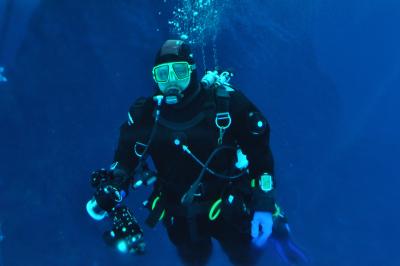
I had the great fortune of working with an innovative and amiable team of researchers attacking questions of “How” and “Why” invertebrate animals in the polar oceans reach relatively large body sizes. “Polar gigantism” is seen in dozens of different groups of organisms and there are almost as many hypotheses seeking to explain it. For Dr. Art Woods, Dr. Amy Moran, Dr. Bret Tobalske, Steve Lane, and Caitlin Shishido, eliminating implausible hypotheses one by one meant using different approaches and techniques. 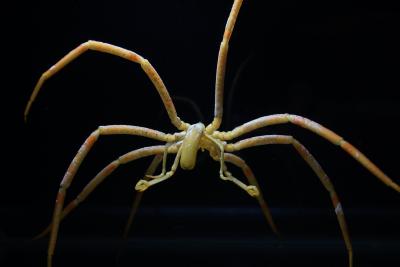
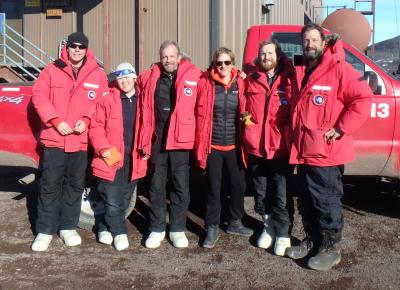
As our research deployment time in Antarctica ran short, a final team meeting delivered a great deal of resolution on two months of process. In this meeting, the five researchers mapped out discrete data sets and discussed the scientific reports each would build — the literature record of the expedition. What I heard in this conversation amounted to a masterclass about how to build and communicate a scientific story. Each story included background of prior research on which the current work was based, then transitioned to the work I participated in and bore witness to, and ultimately moved forward toward future directions following the generated outcomes. As a science teacher, I’m often challenged to illustrate science as a process as well as to demonstrate how that process yields outcomes. Our final meeting helped me compact the cumulative 62 days of scientific experience in the moment. I’ll look for ways for my teaching to resemble this meeting in its modeling of the scientific process.
Daily activities on a frozen continent
In nine weeks of fieldwork, my time was divided nearly evenly between field collections/survey assistance and in-laboratory research manipulations. Both sets of experiences helped me appreciate the multidisciplinary approaches of our research team while also providing enough exposure to learn deeply about certain aspects of the work.
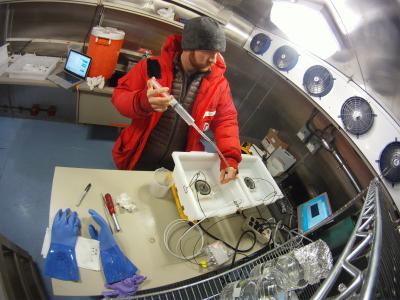
In the laboratory, working with Dr. Art Woods’ direction, I performed a series of metabolic rate trials on sea spiders using a technique known as respirometry. Respirometry places an animal in a closed container of water and measures the change in oxygen dissolved in the water over time. Oxygen is the fuel of cellular respiration, which powers the many biochemical processes of metabolism. An animal in a closed container is metabolizing and using up available oxygen, so the rate of change in oxygen in the container serves as a proxy for the metabolic rate of the animal. Over the span of 12-hour respirometry trials, every 3-hours I would vary the dissolved oxygen in the chambers while an optical recording device tracked the declining oxygen levels. I was entrusted with full ownership over this aspect of the team’s work which added greatly to my understanding of the requirements of each person’s research work. Although there was no time to dig equally deeply into each researcher’s experimental tasks, building my own specific knowledge about the discipline, finesse, and precision required of my own trials gave me insight into the substantial team effort underway.
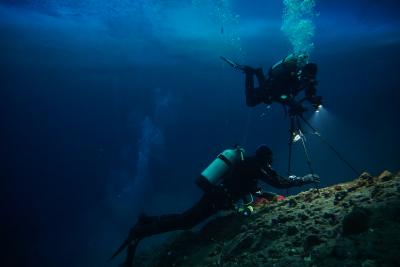
The project’s fieldwork involved under-ice scuba diving at a dozen different locations along the coast of Ross Island and the Antarctic mainland. On a typical day, we would load many hundreds of pounds of diving gear into our PistenBully transports and set out across the sea ice, sometimes up to two hours travel time away from McMurdo Station. Upon reaching the sturdy, heated dive huts — shelters to protect the drilled access holes from freezing shut — the team would again transfer gear. Inside we would suit up in our equipment and drysuits and enter the 28oF water in groups of two or three. Underwater tasks often involved searching for and collecting sea spiders and their egg masses for further examination back at the McMurdo Station lab. I was involved in many ecological surveys of sea spider leg injuries, biomechanical experiments examining walking speed as a function of animal size, and trials to characterize the unique changes in sea spider posture in response to water current speed. I aided in the deployment and recovery of underwater electronics that logged seasonal changes in dissolved oxygen and current velocity. I was also occasionally tasked to photo-document the research work for later conferences, papers, and outreach efforts. In contrast to the highly individual efforts put forth in the lab, our field experiences allowed me to understand how critical a team approach is to accomplishing rigorous fieldwork.
“Thanks for joining me” — Outreach from the field
It’s not always easy to connect with folks from the end of the world. Despite McMurdo Station’s internet bandwidth limitations on the number of allowed connections, our team welcomed over 1124 people to directly view or participate in the fourteen outreach interactions we conducted. Some of the audiences we reached include:
- primary school classrooms in Washington State;
- secondary school classrooms in Washington, Massachusetts, Maine, and New York;
- university lecture halls in Hawaii, Montana, and Washington State;
- an independent school in Cameroon (West Africa);
- a PolarConnect webinar with (conservatively) 717 attendees of all age groups from 12 states and the District of Columbia as well as the United Kingdom and China.
Explorers from around the world were also able to join our team through the 51 PolarTREC journal posts published for the Polar Gigantism in Antarctica expedition. Additionally, I published three dispatches in the Journal of the San Juan Islands, my hometown’s local weekly newspaper.
Classroom connections — Returning to Spring Street International School
The combination of experiences diving beneath the ice, performing physiology experiments with sea spiders, and living at McMurdo Station have provided the raw material for numerous lessons, conversations, and examples in the biology, chemistry, environmental science, and algebra classes I teach. To introduce my students to the concepts examined by the Antarctic research team, I developed a lesson wherein students create model sea spider legs. My biology students and I worked out a method to simulate oxygen diffusion across sea spider exoskeletons by building legs from agar gel and dialysis tubing. The agar gel is infused with a pH-indicator and congeals after being poured within the tubing sections. Students can model variables of exoskeleton pore size as well as leg dimensions impacting surface area and volume, just as the natural system provided variability to my research team.
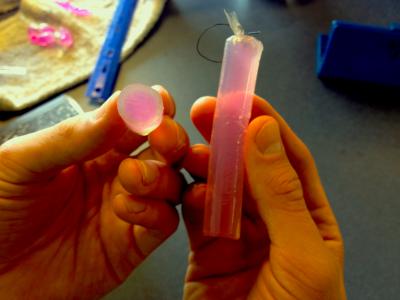
Scuba diving physiology and physics are a natural fit for studies of gas laws in my chemistry class. The tendency for divers to emerge from the icy waters of McMurdo Sound with their regulator’s first stage encased in ice was quickly deconstructed with the help of the combined gas law. The safety margins of dive depth and length enforced by our team and diving supervisors are physiologically explained by Boyle’s and Charles’ laws.
As an environmental science teacher, living at McMurdo Station intrigued me as a logistics exercise to maintain a population of 1,000 people in an environment that can neither provide any of their needs nor accommodate any of their waste. McMurdo Station is an excellent teaching proxy for an ecosystem that provides no goods or services to the humans inhabiting it. You have to go far beyond Earth to find another system to study in this detail. At McMurdo, solutions to these environmental shortfalls must be manufactured, often at great cost. My environmental science class examined this aspect of my experience during their study of environmental economics underlying the absent ecosystem services.
Home again, home again — Post-expedition community outreach
The experience of living and researching on the coldest, highest, driest, and loneliest continent on Earth has captured not only my fascination, but also that of my community. After returning from Antarctica, I have participated in ten different outreach events reaching 493 participants ranging in age from kindergarten to centenarians including:
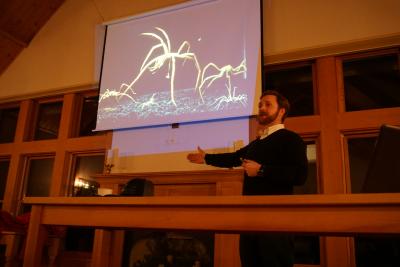
- public presentations to community non-profit organizations;
- visits to schools in the San Juan Islands and Seattle, WA;
- teleconference with a remote classroom in Philadelphia;
- invited lecture at the University of Washington – Friday Harbor Laboratories;
- slide show at a local retirement community;
- public presentations at the Pacific Science Center (Seattle).
Additionally, I co-hosted a table on “Living and Working in Antarctica” at the Pacific Science Center’s Polar Science Weekend. The multi-day event highlighted the work of dozens of Arctic and Antarctic researchers and drew 6,610 visitors to Seattle’s premier science museum.
A far-reaching opportunity
This will be an experience that will continue to feature prominently in my teaching for many years to come, as well as in personal “best-of” experiences for a lifetime. Working alongside a research team has reinforced the importance of “process” to the incremental advancement of knowledge. I have had the opportunity to see rare and spectacular sights and share those with my students. I hope they, too, will someday have the chance to see the same. In the meantime, I will encourage them to dream, plan, and work towards that plan, operating with the understanding that adventures such as this one are possible for people they know.

| Attachment | Size |
|---|---|
| Download Report (1.08 MB)1.08 MB | 1.08 MB |
This program is supported by the National Science Foundation. Any opinions, findings, and conclusions or recommendations expressed by this program are those of the PIs and coordinating team, and do not necessarily reflect the views of the National Science Foundation.
